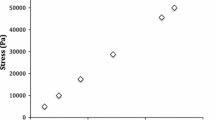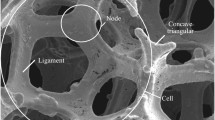Abstract
Physical property-porosity models based on minimum solid areas of idealized stackings of either: (1) spherical particles partially bonded (e.g. sintered), or (2) spherical pores in a solid matrix are shown to agree with appropriate physical property data for bodies whose porosity is reasonably represented by such stackings. Appropriate physical properties are those determined mainly by local stress or flux, e.g. elastic properties, strengths, and electrical and thermal conductivity. The minimum solid areas are, respectively, the: (1) bond (e.g. neck) area between particles defining pores smaller than the particles, or (2) minimum web thickness between adjacent pores being more than or equal to the surrounding particles (e.g. bubbles in a foam). Combinations of the models for mixtures of basic porosity types and changes in basic model parameters (e.g. stacking) over the significant porosity range covered, are shown to agree with the literature (mainly mechanical) property data for bodies of appropriate porosity combinations. Areas of further development and testing are noted.
Similar content being viewed by others
References
R. Rossi, J. Am. Ceram. Soc. 51 (1968) 433.
E. A. Dean, ibid. 66 (1983) 847.
L. F. Nielsen, ibid. 67 (1983) 93.
idem, ibid. 73 (1990) 2684.
N. Ramakrishnan and V. S. Arunachalam, ibid. 76 (1993) 2745.
R. W. Rice, in “Treatise on Materials Science and Technology 11”, edited by R. McCrone, (Academic Press, New York 1977) pp. 199–381.
L. E. Nielsen, Ind. Eng. Chem. Fundam. 13 (1974) 17.
R. W. Rice, J. Mater. Sci. 28 (1993) 2187.
idem, in press.
idem J. Am. Ceram. Soc. 76 (1993) 1801.
idem, in press.
F. P. Knudsen, J. Am. Ceram. Soc. 42 (1959) 376.
M. Eudier, Powder Metall. (9) (1962) 278.
B. Paul, Trans. Metal. Soc. AIME 218 (1960) 36.
R. W. Rice, J. Am. Ceram. Soc. 59 (1976) 536.
R. W. Rice and S. W. Freiman, in “Ceramic Microstructures”, Vol. 76 edited by R. M. Fulrath and J. A. Pask (Westview Press, Boulder, CO, 1977) pp. 800–12.
L. J. Gibson and M. F. Ashby, “Cellular Solids, Structure & Properties” (Pergamon Press, New York, 1988).
K. K. Phani and S. K. Niyogi, J. Mater. Sci. 22 (1987) 257.
K. K. Schiller, in “Mechanical Properties of Non-Metallic Brittle Materials”, edited by W. H. Walton (Interscience, New York 1958) pp. 35–49.
D. P. H. Hasselman and R. M. Fulrath, J. Am. Ceram. Soc. 47 (1964) 52.
J. B. Walsh, W. F. Brace and A. W. England, ibid. 48 (1965) 605.
N. Warren, J. Geophys. Res. 74 (1969) 713.
J. G. Zwissler and M. A. Adams, “Fracture Mechanics of Ceramics”, edited by R. C. Bradt, A. G. Evans, D. P. H. Hasselman and F. F. Lange (Plenum Press, New York 1983) pp. 211–42.
D. J. Green, “Fracture Mechanics of Ceramics”, Vol. 8 edited by R. C. Bradt, A. G. Evans, D. P. H. Hasselman and F. F. Lange, (Plenum Press, New York, 1986) pp. 39–59.
A. N. Gent and A. G. Thomas, Rubber Chem. Technol. 36 (1963) 123.
D. R. Biswas, “Influence of Porosity on the Mechanical Properties of Lead Zirconate-Titanate Ceramics”, Materials and Molecular Research Division Annual Report, Lawrence Berkeley Laboratory, UCAL Berkeley (1976) pp. 110–13.
D. R. Biswas and R. M. Fulrath, Trans. J. Br. Ceram. Soc. 79 (1980) 1.
J. S. Wallace, “Effect of Mechanical Discontinuities on the Strength of Polycrystalline Aluminum Oxide”, MS thesis, U. Calif. Berkeley, Lawrence Berkeley Laboratory, Materials and Molecular Research Division, Annual Report LBL-6016, UC-13, TID-4500-R65 Sept. 1978.
E. E. Hucke, “Glassy Carbon”, University of Michigan Report for Advance Research Projects Agency Order No. 1824 (1972).
O. Ishai and L. J. Cohen, Int. J. Mech. Sci. 9 (1967) 539.
K. K. Phani and R. N. Mukerjee, J. Mater. Sci. 22 (1987) 3453.
J. Francl and W. D. Kingery, J. Am. Ceram. Soc. 37 (1954) 99.
D. Weiss, P. Kurtz and W. J. Knapp, Am. Ceram. Soc. Bull. 45 (1966) 695.
D. S. Rutman, A. F. Maurin, G. A. Taksis and Yu. S. Toropov, Refractories 5–6 (May/June) (1970) 371.
T. Saegusa, K. Kamata, Y. Iida and N. Wakao, Kagaku Kogaku 37 (1973) 811.
J. B. Austin, in “International Symposium on Thermal Insulating Material”. (American Society for Testing and Materials, Philadelphia, PA, 1936) pp. 3–67.
H. Clark, “The Effects of Simple Compression and Wetting on the Thermal Conductivity of Rocks,” American Geophysical Union, Reports and Papers, Tectonophysics, (1941) pp. 543–44.
W. Woodside and J. H. Messmer, J. Appl. Phys. 32 (1961) 1699.
A. Sugawara and Y. Yoshizawa, ibid. (1962) 3135.
L. Coronel, J. P. Jernot and F. Osterstock, J. Mater. Sci. 25 (1990) 4866.
K. R. Mckinney and R. W. Rice, “Specimen Size Effects in Fracture Toughness Testing of Heterogeneous Ceramics by the Notch Beam Method”, Special Technical Publication 745 (American Society for Testing and Materials, Philadelphia, PA, 1982) pp. 118–26.
D. Ashkin, R. A. Haber and J. B. Wachtman, J. Am. Ceram. Soc., 73 CH. 1990 pp 3376–81.
D. Ashkin, PhD thesis, Rutgers University (1990).
S. C. Park and L. L. Hench, Sci. Ceram. Chem. Proc. (1986) 168.
T. Fujiu, G. L. Messing and W. Huebner, J. Am. Ceram. Soc. 73 (1990) 85.
T. Woignier and J. Phalippou, J. Non-Cryst. Solids 100 (1988) 404.
M. A. Ali, W. J. Knapp and P. Kurtz, Bull. Am. Ceram. Soc. 46 (1967) 275.
D. J. Green and R. G. Hoagland, J. Am. Ceram. Soc. 68 (1985) 395.
D.J. Green, ibid. 68 (1985) 403.
R.W. Rice, ibid. 58 (1975) 458.
Y.L. Krasulin, V.N. Timofeev, S.M. Barinov, and A.B. Ivanov, J. Mater. Sci. 15 (1980) 1402.
L. J. Trostel Jr, J. Am. Ceram. Soc. 45 (1966) 563.
R. W. Rice, Mater. Sci. Eng. A112 (1989) 215.
J.J. Gilman, in “Fracture”, edited by B.L. Auerbach, D.K. Felbeck, G.T. Hahn and D.A. Thomas, (MIT Technology Press, Wiley, New York, 1959) pp. 193–224.
R.W. Rice, J. Am. Ceram. Soc. 77 (1994) 2232.
idem, to be published.
C.CM. Wu and R. W. Rice, Ceram. Eng. Sci. Proc. 6 (1985) 977.
Author information
Authors and Affiliations
Rights and permissions
About this article
Cite this article
Rice, R.W. Evaluation and extension of physical property-porosity models based on minimum solid area. JOURNAL OF MATERIALS SCIENCE 31, 102–118 (1996). https://doi.org/10.1007/BF00355133
Received:
Accepted:
Issue Date:
DOI: https://doi.org/10.1007/BF00355133




